9 Tips for Traveling to Maui Responsibly As the Island Recovers From the Wildfire
By enjoying and investing dollars in the local economy, you can help locals rebuild.
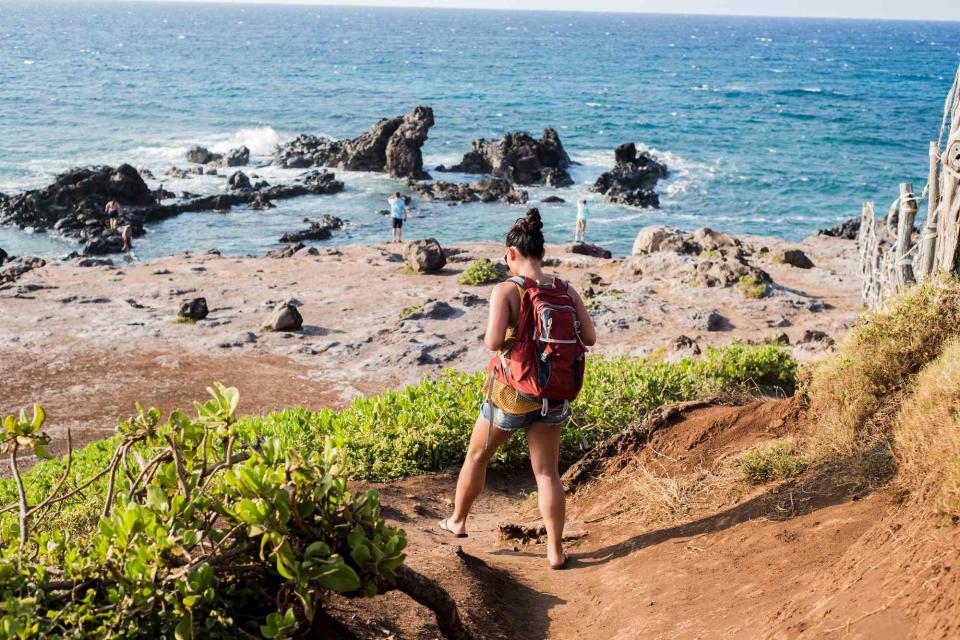
Rosanna U/Getty Images
The August 2023 wildfire that swept through Lahaina and portions of upcountry Maui marked the worst natural disaster in Hawaiian history and ranks as one of the top 10 deadliest wildfires since the National Fire Protection Association (NFPA) began keeping records in 1871.
Recovery is an ongoing, multipronged process. For the first several weeks, government officials and those involved in relief efforts asked travelers to steer clear to allow for planes and resources to be utilized by first responders and locals. Instead of rushing in to support on the ground, outsiders were asked to donate to nonprofits like the Maui Food Bank, Maui Humane Society, Aloha United Way, and other organizations on the front lines.
Three months later, the healing continues across the 2,100-plus acres the fires impacted — and the island and state as a whole. However, now, rather than asking travelers to keep their distance, Maui lawmakers, businesses, tourism officials, and the vast majority of locals Travel + Leisure spoke to on the ground in early November are ready to welcome back guests. In fact, Hawaii's second-largest and second most visited island needs guests to return.
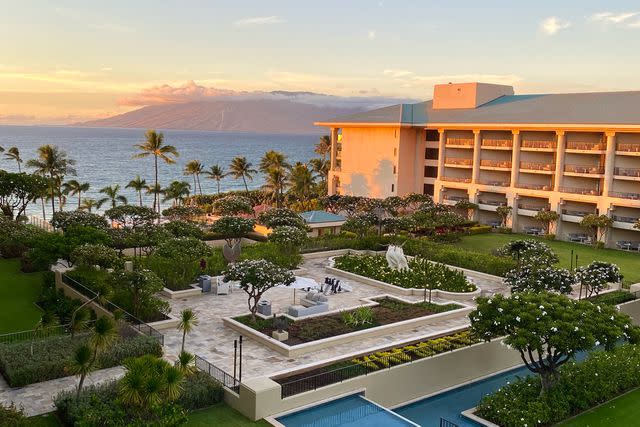
Karla Walsh
Tourism dollars not only keep businesses afloat and individuals employed (about 8,000 unemployment claims have been filed since the wildfire, tourism officials told T+L), the money also funds road upkeep, schools, and public gathering places, as well as supports state and county taxes.
According to the Hawaii Department of Business, Economic Development, and Tourism, 38 percent of Maui’s economy and nearly 85 percent of Maui’s jobs depend on visitor spending. In a typical year, about three million tourists visit the island and invest about $5.4 billion in the local economy. This year is proving to be far from typical, as local businesses and hotels told us their guest counts are drastically down.
In addition to the financial contributions tourists can make, traveling responsibly and respectfully to the open areas of the lush island gives visitors a chance to partake in one of the core aspects of Hawaiian culture: storytelling. “Talk story” helps keep the area’s rich traditions, history, and respect for the land (and each other) alive.
Despite the wildfire’s destruction, current-day Maui residents are becoming part of that rich history through their generosity and resilience. Take Kainoa, who quickly shifted from his day job educating companies about Hawaiian culture with Mo'olelo Group to scaling up operations with Maui Rapid Response and Global Empowerment Mission to mobilize collection and distribution centers across the island in a matter of days.
Or, Paula, a mom of two and Old Lahaina Luau star, who now dedicates her days as a volunteer coordinator for Hua Momona Farms’ relief efforts to help feed displaced families.
Or, the team at Mediterranean restaurant Pizza Paradiso, who were just blocks away from Lahaina’s blaze, yet opened on Aug. 15 to partner with José Andrés' World Central Kitchen to offer free slices and Dole Whip to Maui residents.
Then, there's the courageous staff of 52-year-old Trilogy Excursions. Even after losing their Lahaina transport vehicles and witnessing their office close, their captains “didn’t think twice” about jumping into the ocean to help the Coast Guard rescue 50 people who ran into the waves to try and escape the flames.
The resilient humans on Maui became part of this story that travelers can witness, hear about (and possibly meet while visiting), and learn lessons from for a lifetime.
Before T+L returned to the airport to fly home after a week on the island, we spoke with Kamahiwa Kawa'a, manager of Hawaiian culture at Fairmont Kea Lani. During a traditional haku lei ceremony, he shared a 1615 Hawaiian proverb that’s perfectly fitting for this moment: “Kau ka pe'a, holo ka wa'a.”
“Kau ka pe'a, holo ka wa'a translates to ‘up go the sails, away goes the canoe.’ This proverb can be interpreted in many different ways — one being that we set our sails and continue onward in our canoe, heading to the same direction and end goal,” Kawa'a explained. “In times of difficulty, trials, joy, and happiness, no matter the outcome or the circumstances we face, we continue to hoist the sails and push onward toward greater things.”
Here are nine ways you can help Maui — and Hawaii — raise those sails as they continue to recover.
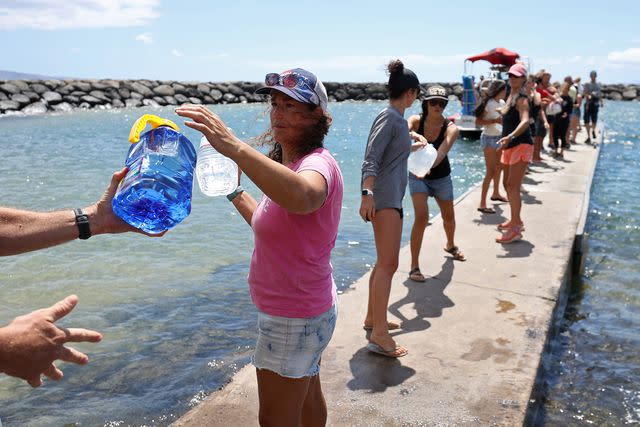
Justin Sullivan/Getty Images
Set aside time for voluntourism.
Tourism officials recommend that, if possible, travelers carve out some time — even just a few hours or one day — to lend a hand in a way that aligns with their abilities and values. If you’re a gifted gardener, roll up your sleeves to plant new native trees, shrubs, or flowers with the Coral Reef Alliance. Love to cook? Spend a day transforming ingredients into warm meals for first responders with Hua Momona Farms, or aid in sorting through food donations with a group like Feed My Sheep. If you miss your pets every time you start packing your bags, share that love by spending a few hours helping at an animal-focused organization, like the Leilani Farm Sanctuary.
“There are so many different things happening around the world right now that deserve our attention. Maui is one of them,” explained Kainoa Horcajo, who continues his work with Global Empowerment Mission to provide housing options, volunteer management, and other direct mutual aid to those impacted by the wildfire. “I know there are millions of people across America and the world that feel a sense of connection to Maui, because they've traveled here or because they've always wanted to. One could say that it gives you a kuleana [responsibility or cause] to aid in our recovery and to help give life, hope, and a future back to a place that gave you something.”
Frequent local restaurants and shops.
Aside from your talents, you can invest your funds at places locals love — and own. Created by the County of Maui's Office of Economic Development, the Maui Nui First directory showcases stores, lodging options, dining establishments, and events. (During our time on the island, we quickly fell in love with Café Des Amis in Paia, The Market in Wailea, Komoda Bakery in Makawao, and Tiffany’s in Wailuku.)
Stay at a property with strong cultural programming.
Soak up unforgettable pieces of that storytelling by living amidst it. For example, at Four Seasons Resort Maui at Wailea, which was just voted one of T+L readers' favorite resorts in Hawaii in 2023, guests can sign up for A Wayfinder’s Journey. During the private catamaran excursion for up to six people, travelers will learn from distinguished female navigator Kala Baybayan Tanaka about how ancient Polynesians turned to the stars, sea, and other natural elements to make their way from other lands to Maui. Chef Samual Taganeca brings those stories to life on the plate, which is part of a multicourse menu focused on “canoe plants,” or the ingredients those Polynesian sailors brought with them on their journey.
All guests who stay on property can take part in complimentary lei-making classes, outrigger canoe excursions (complete with history lessons), and palm frond-weaving sessions, as well as stroll through on-site local artist fairs. Through Dec. 15, guests can also dedicate up to $200 from each night of their stay to go directly to the Maui Strong Fund.
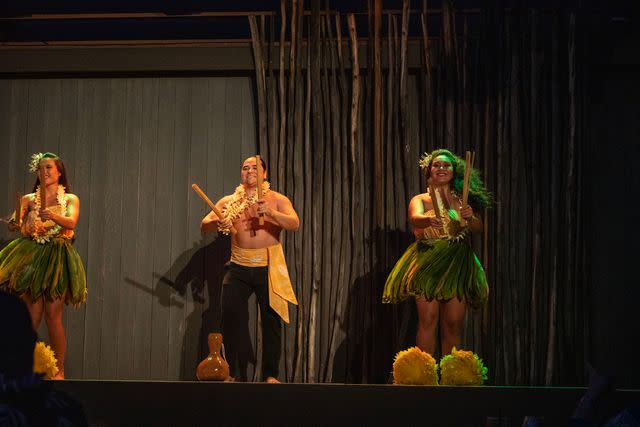
Taylor McIntyre/Travel + Leisure
Book excursions.
There are many activities residents aren’t likely to do as much as those on vacation, including helicopter outings, zip lining, luxe spa treatments, brewery or winery tastings, cocktail or cooking classes, and farm tours. While it might seem insensitive to learn how to master a mai tai across the island from where the fires took place, each dollar going back into the businesses helps move the needle to support the economy and the staff at those venues.
During peak season, Skyline Hawaii guides host nine groups per day, six days a week. Now, they’re open three days weekly for one to two sessions. Owner Danny Boren is passionate about plant conservation efforts, and restoring Maui forest land has been built into his now-B Corp business since day one. As revenue grew, he was able to dedicate more dollars to buying plants and launching his “native guide program” as a way to deal with seasonality within the tourism industry. When guides aren’t leading guests across zip-line runs, they plant and track the growth of seeds. To date, Skyline Hawaii has put 20,000 plants in the ground and reintroduced 38 species that were once extinct. The native guide program has kept staff employed this year, though the overall business relies on revenue from guest bookings to purchase plants and pay staff. The ripple effects of a decrease in tourism extend much further than one might think upon first glance. (In other words, it’s not insensitive to explore and enjoy the many open parts of the island.)
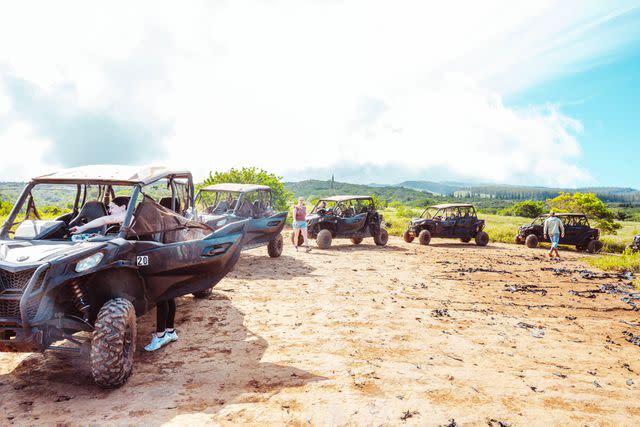
Taylor McIntyre/Travel + Leisure
Tip generously.
As you wrap up your experiences, meals, or stays, don’t forget to tip the staff on the tour, in the restaurant or bar, at the spa, or on housekeeping duty. Many tourism-related careers rely heavily on tips. Even small dips in guest counts can make a sizable difference in their income.
Certain venues also offer a bonus donation field on receipts to make it easy for visitors to chip into a collective fund that’s split among all staff — or dedicated to those displaced.
Pack your patience, compassion, and an open mind.
As businesses continue to pivot through the recovery, and as people continue to process what happened, know it won’t always be “business as usual.” Certain venues are decreasing hours or days of operation due to the fact that they don’t have enough visitors to justify opening, or staff available to support guests. That being said, most are open for business and excited to welcome visitors to encounter some of what makes Maui so magical.
Don't pry, but if locals open up about the fire, listen.
“Were you impacted by the fire?” “How is the recovery going?” Questions like these might be asked with the notion that they’re supportive, but many survivors aren’t ready to share their experiences with others, especially those who don’t call Maui home. Don’t introduce the topic, but if they do, listen and offer compassion.
Follow government mandates about places to avoid.
The Hawaii Tourism Authority said they're “continuously coordinating efforts with federal, state, and county emergency management officials” to determine where to allow visitors and when.
Fire-affected areas of Lahaina are still closed to the public, and some lodging is being dedicated to housing those who were displaced, but after a three-phase reopening process, the bulk of Maui is open for business.
Still, the Hawaii Tourism Authority asks travelers to “check with individual accommodations, activities, and businesses in West Maui for their availability and hours of operation.” And be sure to heed any local signs and police guidance about off-limit areas. Lastly, respect residents by not taking photos of restricted regions.
Consider adding on to your trip.
The Hawaiian islands are all one big ‘ohana (family), and in normal times, many vacationers make a multi-island trip. Building environmental and economic resiliency is a collective effort that stretches beyond Maui, so if your schedule allows, we recommend booking a few days on Oahu, Kauai, Lanai, or the big island, too.
Don’t feel quite ready to travel to Maui yet, or perhaps you have a full vacation itinerary for the next several months? You can still support local businesses from afar by purchasing their products online.
In fact, Rudy Balala, general manager of Maui Gold Pineapple Company, told T+L, “An increase in direct-to-consumer online sales after the wildfire is what saved us. We lost 40 percent of our business on the west side after the fires.” Balala noted that they supply many local high-end markets, restaurants, and hotels. Maui Gold ships their locally grown pineapples to all 50 states and Canada.
Other shippable Maui favorites include Hi Spice for hot sauce, ‘Alohi Maui for beauty and skin care, Malani & Lehua Jewelry Co., The Maui Cookie Lady, Maui Ku’ia Estate for chocolates, Polipoli Farms for herbal teas, and Treehouse Designs for accessories.
You can also donate directly to a variety of Maui Nui Strong organizations, including those affiliated with some of the impactful companies mentioned above, like the Trilogy Maui fire fund, Global Empowerment Mission Maui wildfire fund, Hua Momona Foundation Maui relief, and the Hawaii Community Foundation’s Maui Strong Fund.
For more Travel & Leisure news, make sure to sign up for our newsletter!
Read the original article on Travel & Leisure.


